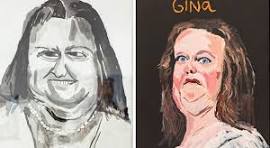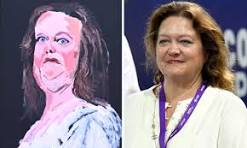
Billionaire mining magnate Gina Rinehart not only requested the removal of two unflattering portraits of herself from the National Gallery of Australia but also demanded they be “permanently disposed of.”
Emails released by the gallery under freedom of information laws on Thursday reveal that Rinehart reached out to the NGA’s chair, Ryan Stokes, on April 8 with the following message: “Hi Ryan, I know [words redacted], but now that I’m told you’re chair of the national gallery, can u pl permanently dispose of the 2 so-called portraits of me below.”
The email included images of the portraits by award-winning Western Aranda artist Vincent Namatjira, which were part of his solo exhibition, Australia in Colour, that had opened at the gallery a month prior.

Stokes responded quickly, forwarding Rinehart’s request to the gallery’s director, Nick Mitzevich, with a note that read: “Nick– here is an interesting one … not sure entirely how we will respond but we will need to think about it …”
Mitzevich immediately drafted a suggested response for Stokes, proposing to say: “Dear Gina, Perhaps what might be helpful is if the Director of the National Gallery speaks with someone you nominate to discuss the context and possible options.”
In his draft, Mitzevich included instructions for contacting him directly and added to Stokes, “Let me know if you would prefer a more substantial response, but it’s probably not helpful to debate the artistic merits of the paintings.”
On May 15, a month after Rinehart’s request, Mitzevich warned Stokes that the media had begun asking about Rinehart’s attempt to remove the portraits. He also mentioned a phone call from Arts Minister Tony Burke about the issue. Stokes responded, “We need to let her people know about it.”
Within hours, the story was published in Nine newspapers and quickly spread to major media outlets, including The Guardian. By the following day, it had gained international attention.
Despite pressure from Rinehart, who is better known for her philanthropy in Australian sports than the arts, the National Gallery stood firm. The portraits remained on display until the exhibition closed on July 21.
In a statement issued on May 15, the gallery noted: “Since 1973, when the National Gallery acquired Jackson Pollock’s Blue Poles, there has been a dynamic discussion on the artistic merits of works in the national collection and/or on display at the gallery. We present works of art to the Australian public to inspire people to explore, experience, and learn about art.”
Earlier documents, also released under freedom of information laws, revealed that Rinehart had become aware of the portraits after a “concerned friend” brought them to her attention.
Rinehart’s campaign seemed disappointed, stating that they did not include giving an approved portrait to the gallery.




